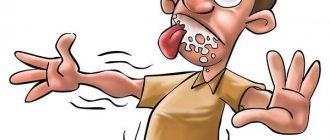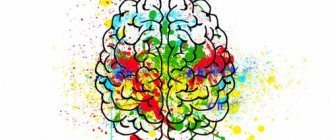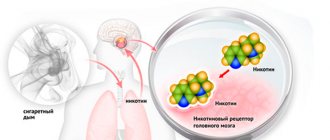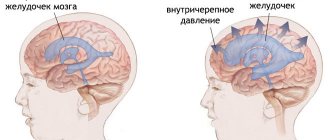Many people live according to a set routine, they do the same things every day, and changing the usual rhythm of life unsettles them. This behavior is rigidity, and in minor manifestations it is safe and even useful. Serious deviations require the intervention of specialists and correction by psychotherapists.
What is it in psychology: definition
Rigidity is considered from a psychological point of view as the partial or complete inability of the subject to change the program of his actions in accordance with the current situation.
Often in people’s lives, circumstances objectively develop in such a way that there is a need to adapt to new conditions and change their usual style of thinking and behavior.
A rigid psyche does not allow a person to adapt to the situation .
Moderate expression of individual traits has a positive effect on the quality of life of an individual in society.
Causes and characteristics of the disease
The pathogenesis of the disease is not fully understood; epidemiological testing suggests that the cause is a decrease in the level of the neurotransmitter dauphine in the substantia nigra and basal ganglia of the brain. The anomaly was described by American doctors FP Moersch and HW Woltman and was called Moersch and Woltman syndrome. Scientists have classified it as a hereditary disease.
The genetic cause of inferiority of subcortical functions can appear suddenly with rapid progression under the influence of various factors:
- hydrocephalus;
- paralysis with trembling of limbs;
- complications of encephalitis;
- genetically predisposed parkinsonism;
- hepatolenticular degeneration (liver cirrhosis);
- blockage of blood vessels in the brain with cholesterol plaques (atherosclerosis);
- intoxication with manganese or carbon monoxide;
- basal degeneration, expressed by calcification;
- amyotrophic sclerosis;
- damage to the central nervous system by the causative agent of syphilis;
- suffered a traumatic brain injury;
- HIV (human immunodeficiency virus);
- side effects during therapy with phenothiazine antipsychotics.
Parkinson's disease is considered the main provocative factor for hypokinesia.
Rigid man, who is this?
Such people are very attached to stereotypes; it is a big problem for them to change their worldview. The reason lies in the poor development of the sensory sphere .
That is, one’s own sensations and experiences are less important than the experience accumulated by past generations.
A person is distinguished by pedantry, accuracy, responsibility, accuracy and logical thinking. He rarely changes his habits and is distinguished by his pronounced stubbornness.
Emotionally impressionable: important events and phenomena can change your state of mind for a long time. External stimuli are not able to have a significant impact on the value systems of such people.
They practically do not change under the influence of external circumstances or other people, and demonstrate a lack of ability for self-regulation and self-correction .
People with moderate rigidity are excellent workers in areas that do not require flexible thinking.
They are distinguished by pedantry, thoroughness and diligence .
They always rely on their own experience and perform their duties clearly and accurately. Such people are greatly irritated and unsettled by the irresponsibility, superficiality and carelessness of others.
They are less susceptible to stress than other members of society due to their weak susceptibility to general trends and moods.
Such mental stability contributes to the formation of leadership qualities : confidence in one’s position in life, the ability to systematically move towards a set goal, strict self-discipline, and a tendency to compete.
Typical Features
Typical features of behavior, speech, and thinking are identified.
Behavior
Rigid people exhibit conservative behavior .
Unexpectedly changing environmental conditions cause them rejection and stupor.
The chances of adaptation in extreme situations are quite low.
They always try until the last moment not to acknowledge the changes taking place and not to change their usual style of behavior. Unpreparedness for change does not in any way affect your overall self-confidence.
The self-esteem and self-esteem of such people are always maintained at a fairly high level, thanks to which they are able to achieve a significant social position even in the absence of the necessary mental plasticity.
Thinking
People of this psychological type have the following thinking characteristics:
- Stubbornness .
Confidence in one’s own rightness and inability to objectively perceive criticism directed at oneself. A person always defends his personal point of view, considering it the only correct one. - Impressionability . Even minor events related to significant aspects of life can cause strong emotional distress. The feelings experienced cannot be hidden from others.
- Stability of beliefs . The existing system of moral attitudes, opinions and beliefs cannot be influenced from the outside.
- Inability to show flexibility . The need to adapt to a changed situation often requires people to change their behavior and abandon their plans. Rigid individuals, unlike flexible ones, cannot accept the fact of change and adjust to different circumstances.
Speech
Rigid speech means monotony of words , frequent use of cliches and pauses. Sometimes this definition is applied to the slow speech of the interlocutor.
The reason may lie in the characteristics of temperament, lack of vocabulary , unconsciously copying the manner of speaking of other people.
The peculiarity of speech may also indicate insufficient development of intelligence. To quickly and flexibly select suitable words during a conversation, you need to have a high level of intelligence.
Educated, well-read people always have an extensive vocabulary. They are able to select synonyms for words and adjust the manner of conversation depending on the proposed circumstances (social circle, environment, etc.).
Since the individual’s psyche has integrity, the general rigidity of thinking and behavior can be directly reflected in speech.
Rigidity is:
Rigidity
Although the term R. does not have a precise definition, it can be said that R. is especially evident when an individual fails to change his behavior, even if the needs of the new situation require different behavior.
Many terms in psychology indicate R., incl. perseveration, conservatism, dogmatism, anality, intolerance of uncertainty and compulsivity. Terms such as flexibility, lability, tolerance of ambiguity and, to some extent, creativity denote tendencies opposite to R.
Rigidity as perseveration. Goldstein believed that, under normal circumstances, a healthy individual functions as a complete system with well-integrated and distinct subsystems. However, in the damaged brain, system integration is impaired and the individual is unable to cope with the complexity required by abstract problems. Goldstein argued that the rigid, frozen behavior exhibited by brain-damaged patients is not so much a loss of function as an attempt to reduce complexity and make a potentially overwhelming situation manageable.
Laboratory research. showed that when subjects were given several problems in a row that had a fixed solution method, they often continued to rigidly use the same solution method for subsequent problems, even if these new problems could be solved in different ways.
Intolerance of uncertainty. A number of researchers and theorists have observed a fairly consistent constellation of traits, which include strict obedience to authority figures, intolerance of opposing opinions, prejudice, a tendency to create an overly simplified view of the world, a tendency to use sharply polarized cognitive constructs, and a cynical view of the nature of people.
Discussions about rigid, authoritarian, and dogmatic belief systems have extended to psychopathology. In the clinic, highly dogmatic and rigid behavior can be observed in obsessive-compulsive and paranoid patients.
Integration of approaches. Piaget showed that thinking in the early stages of child development is characterized by over-assimilation and over-accommodation, and convincingly demonstrated that young children and mentally retarded adults use one-dimensional, rigid, “centered” cognitive strategies in comparison with the multidimensional, flexible, “decentered” strategies used by older people children and normal adults. According to Piaget, affective and moral development are inseparable from cognitive development. Consequently, rigid behavior found in cognitive tasks has its parallels in the lack of autonomy, manifestation of perseverativeness and rigid constructions of personal and interpersonal values found in social media. behavior.
It is possible that rigidity, both in the intellectual and affective spheres, is a manifestation of unbalanced schemes, in which either accommodation or assimilation predominate. Since many factors, incl. Cognitive immaturity, neurological damage, and authoritarian-oriented parenting may interfere with the development of adequately balanced circuits, and rigidity may have various roots.
See also Obsessive-compulsive personality
B. Gorman
.
dic.academic.ru
Varieties
There are three main groups of rigidity:
- Cognitive . The desire to constantly adhere to standard, developed patterns of behavior. Lack of ability to develop a new plan of action taking into account changed initial circumstances.
- Affective . The absence of a relationship between ongoing events and the severity of the emotional reaction to them. Affective rigidity manifests itself in excessive concentration on objects and overvalued ideas.
- Motivational . Violation of the motivation system. There is no desire to perceive new motives for carrying out activities. Unwillingness to give up formed needs and their usual satisfaction.
Types of people
Psychologists identify several types of people who are distinguished by pronounced rigid behavior:
- ", Flower", .
The person demonstrates detachment from his social group. His contribution to the common cause is minimized. This causes irritation among group members, which negatively affects the mental state of the individual. - ", Jester", . Cynicism and harsh judgments often have a negative impression on others. Making fun of other people or serious issues leads to problems in making connections.
- "Grumpy", . Any unforeseen events cause dissatisfaction and irritation. A person is constantly in a bad mood, which he demonstrates to others. Constant complaints are annoying and kill any enthusiasm.
- "Conspirator" . Does not pay attention to the needs of other members of his social group, adhering to personal beliefs. There is a tendency to create isolated associations, which ultimately lead to the disintegration of stable groups.
- "Doubting Thomas", . A skeptic who never believes in possible success. Rigidity of thinking extends not to individual issues, but to the entire surrounding reality.
Degree of development of the disease
Stiff person syndrome is classified according to the form of the disease:
- the initial appearance is determined by stiffness of the joints, limitation and speed of movements (akinesia), muscular myasthenia;
- the mixed rigid form is accompanied by muscle degeneration and tremor of the limbs and jaw;
- the trembling stage is characterized by normal muscle tone, there is no weakness, but the arms and legs are in constant vibration.
The latter classification deprives a person of the ability to eat independently and move fully.
Advantages and disadvantages
Moderate expression of such a mentality is an exclusively positive aspect. Such people are usually quite sociable and self-confident.
They have an active life position, which helps them achieve a stable social position.
In a social group they demonstrate excellent organizational skills, dedication and responsibility. You can always rely on them.
Pronounced mental rigidity is a negative aspect that can complicate the social existence of an individual.
Stubbornness, cynicism, extreme conservatism, reluctance to adapt to circumstances are all negative character traits that have a negative impact on the ability to build contacts with other people.
Pathological conditions in which mental abnormalities occur (paranoia, psychosis) are also possible
In this case, the person demonstrates excessive conflict, obsession with his ideas, and egocentrism.
Measurement technique
The main method for identifying relevant character traits is conducting psychological research in the form of testing . Answers to specially selected questions in the test reveal the presence of standard features:
- retention of sensation from any stimulus for a long time,
- problems with changing habitual physical activity,
- prolonged experience of events that are long in the past,
- inability to change habitual ways of achieving goals,
- obsession with ideas.
It should be borne in mind that a person can be rigid in one manifestation and flexible in another.
Multidirectional test questions allow you to obtain the necessary information. It is possible to identify the peculiarities of the psyche as a result of conversations.
As a rule, people of this psychological type find it difficult to engage in conversation and slowly switch from one topic to another.
Their speech is slow and thoughtful .
They analyze information and respond with logical conclusions.
In response to the questions posed, specific answers without being distracted by extraneous issues.
Forecast
Precise use of currently available medications can improve life prospects. In its advanced form, without treatment, akinetic-rigid syndrome leads to paralysis, and a person will not be able to move without crutches. The prognosis for this disease is quite difficult to predict. With the help of adequate therapy, motor function is maintained and the progression of pathology is slowed down; in the worst case, hypokinesia triggers irreversible processes in the body. Timely seeking qualified help can guarantee the normalization of muscle tone, and the person will continue to lead a normal lifestyle.











